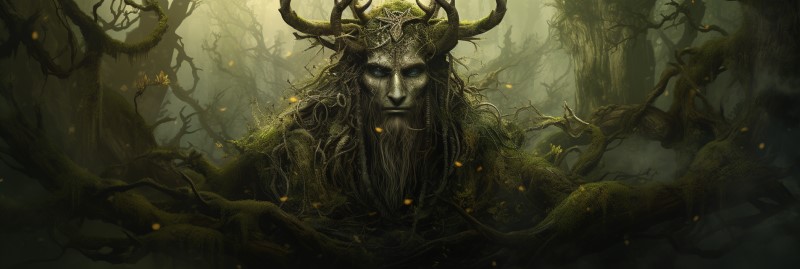KidZone Geography: Celtic Mythology
Celtic Horned God, Cernunnos

Introduction
Cernunnos is a deity of ancient Celtic mythology, often associated with animals, forests, fertility, and wealth. Recognized by his antlers, Cernunnos embodies the untamed spirit of nature, the cycle of life and death, and the connection between the material world and the spiritual realm. His imagery, found in various artifacts across the Celtic world, depicts him as a mediator between humans and nature, symbolizing prosperity, ecological balance, and the cyclic nature of life. Cernunnos's presence in Celtic lore underscores the ancient Celts' reverence for the natural world and their understanding of humanity's place within it.
Mythological Origins
Cernunnos's origins are shrouded in the mists of Celtic history, with his presence felt more through iconography and the symbolic significance of his attributes than through written mythology. He appears on the Gundestrup Cauldron, a notable piece of Celtic art, as a horned figure surrounded by animals, suggesting his ancient role as a god of nature, fertility, and the animal kingdom.
Physical Description and Symbols
Cernunnos is traditionally depicted as a man bearing the antlers of a stag, symbolizing his deep connection to wildlife and the forest. His representations often include him seated in a lotus position, indicative of a meditative or shamanic aspect, suggesting a role as a bridge between worlds. Surrounding him are often symbols of abundance and prosperity, such as the cornucopia, and animals like the stag, bull, and serpent, highlighting his dominion over nature and the cycle of life and regeneration.
Powers and Abilities
As a deity of fertility and wealth, Cernunnos is believed to possess the power to foster growth and abundance, both in nature and in human life. His influence extends over forests, animals, and ecological cycles, ensuring the balance and harmony of the natural world. He is also seen as a guardian of the gateway between the physical and spiritual realms, guiding souls in the afterlife and overseeing the cycle of rebirth.
Notable Myths and Stories
The specific myths surrounding Cernunnos are sparse, as much of Celtic mythology was transmitted orally and only fragments have been preserved through Roman and later Christian sources. However, his enduring presence in Celtic art suggests a significant role in rituals and beliefs, possibly related to the changing seasons, harvests, and hunts.
Worship and Cult Centers
Evidence of Cernunnos's worship is primarily archaeological, found in artifacts and inscriptions across regions of ancient Gaul, Britain, and other Celtic lands. His imagery in sacred groves, on altars, and in other ritual contexts suggests that natural settings played a significant role in his veneration, reflecting his connection to the earth and its cycles.
Symbolism and Cultural Significance
Cernunnos embodies the intertwining of life and death, the prosperity that comes through ecological and spiritual balance, and the cyclic nature of the cosmos. His antlers, simultaneously representing the forest's canopy and its roots, symbolize the unity of all life, the regenerative power of nature, and the eternal cycle of growth and decay.
Comparative Mythology
Cernunnos shares similarities with other horned deities in various mythologies, such as Pan from Greek mythology, who is associated with nature, shepherds, and flocks, and the Hindu god Pashupati, a protector of animals. These figures represent the vital and untamed aspects of nature, as well as the fertility and virility that sustain life.
Fun Facts or Trivia
The name 'Cernunnos' is derived from the Celtic word "cernu," meaning "horned" or "antlered," reflecting his most distinctive attribute. The lack of written records makes his original name and attributes a subject of ongoing research and interpretation.
Artistic Representations
Cernunnos's depictions in ancient Celtic art, such as the Gundestrup Cauldron, and in modern interpretations, emphasize his connection to the natural world and his role as a provider of abundance and protector of animals. These artistic renditions often highlight his serene yet powerful demeanor, embodying the dual nature of nature's nurturing and wild aspects.
Activities or Reflections
Nature Meditation: Engage in a meditation session in a natural setting, focusing on the interconnectedness of all life forms and the cyclic patterns in nature. Reflect on Cernunnos's role as a mediator between the natural and spiritual realms.
Ecological Stewardship Project: Inspired by Cernunnos's connection to nature and animals, participate in or organize a conservation project that aims to restore a natural habitat, protect wildlife, or promote biodiversity in your local community.